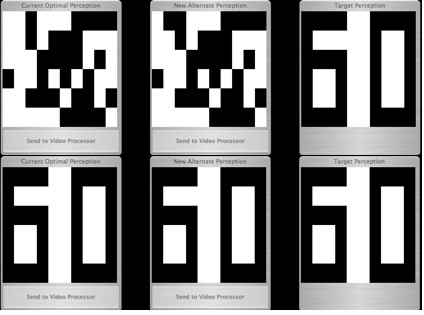Optimization of Electrical Stimulation Patterns for Artificial Vision Implants
A great challenge exists in predicting how to electrically stimulate the retina of a blind subject via the Artificial Retina, a visual prosthesis, to elicit a desired visual perception. In epi-retinal stimulation, as is the case with the Artificial Retina, the electrical stimulus emission occurs at the ganglion cell layer, i.e., at the end of the retinal neural network structure and processing cascade, feeding directly into the optic nerve. Consequently, it is difficult to predict how to electrically stimulate the retina of a blind subject with a visual prosthesis to elicit a visual perception that matches an object or scene as captured by the camera system that drives the prosthesis. The electronic system must substitute for the information processing normally performed by retinal circuitry. This research is part of the collaborative U.S. Department of Energy-funded Artificial Retina Project designed to restore sight to the blind.
To improve the visual experience provided by a visual prosthesis such as the Artificial Retina requires the efficient translation of the camera stream, pre-processed by the Artificial Retinal Implant Vision Simulator (ARIVS), into spatial-temporal patterns of electrical stimulation of retinal tissue by the implanted electrode array. The Visual and Autonomous Exploration Systems Research Laboratory at Caltech, under direction of Dr. Wolfgang Fink, directly addresses this challenge by developing and testing multivariate optimization algorithms, which are based on evolutionary principles. These algorithms directly involve the blind subjects for the evaluation of their visual perception. The optimization process helps define and optimize the electric stimulation patterns administered by the Artificial Retina to instill useful visual perceptions in blind subjects of objects or scenes that are viewed with the external camera system and pre-processed by ARIVS.
In the actual test setup, the blind subject experiences alternating electrical stimulation patterns via his vision implant that correspond to a Current Optimal Perception and a New Alternate Perception (see Figure below). These electrical stimulation patterns are generated as part of a Stochastic Optimization Framework (Fink, 2008; Fink and Tarbell, 2008), which offers a novel approach for optimizing visual perception that does not rely on assumptions regarding the residual processing capability or architecture of the affected retina, let alone on modeling of the retina. The blind subject is asked to decide whether the resulting Current Optimal Perception or the New Alternate Perception generate a visual perception that better approximates a certain pre-defined Target Perception (see Figure below). A Tactile Feedback Device, also developed at Caltech, displays the Target Perception (ground-truth) in the form of a pin-pattern to the blind subject. This approach of presenting the ground-truth perception to the blind subject takes advantage of the well-developed tactile sense of blind subjects, and together with the simultaneous electrical stimulation of the retina provides a promising way towards the optimization of visual perception of retinal implant carriers.

Wolfgang Fink, Ph. D.
Senior Researcher at Jet Propulsion Laboratory (JPL)
Visiting Research Associate Professor of Ophthalmology at University of Southern California (USC)
Visiting Research Associate Professor of Neurosurgery at University of Southern California (USC)
Visiting Associate in Physics at California Institute of Technology (Caltech)
Mailing Address:
California Institute of Technology
Visual and Autonomous Exploration Systems Research Laboratory
15 Keith Spalding (corner of E. California Blvd & S. Wilson Ave)
Mail Code 103-33
Pasadena, CA 91125
USA
Phone: 1-626-395-4587
Fax: 1-626-395-4587
E-mail: wfink@autonomy.caltech.edu
Licensing Contact
Office of Technology Transfer at Caltech.
